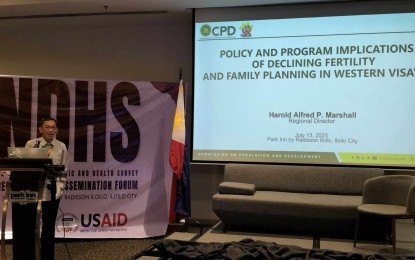
LOW FERTILITY RATE. Commission on Population and Development (CPD) Regional Director Harold Alfred Marshall speaks during the regional dissemination forum for the 2022 National Demographic and Health Survey (NDHS) held in Iloilo City on Thursday (July 13, 2023). He said the declining total fertility rate (TFR) in the region provides the opportunity to accelerate development, reduce poverty and improve labor force participation. (PNA photo by PGLena)
ILOILO CITY – The Commission on Population and Development (CPD) in Western Visayas says the declining total fertility rate (TFR) in the region provides an opportunity to accelerate development, reduce poverty and improve labor force participation and should not be a cause for alarm.
CPD Regional Director Harold Alfred Marshall talked about the policy and program implications of the TFR result during the regional dissemination forum of the 2022 National Demographic and Health Survey (NDHS) final report held in a hotel in this city on Thursday.
“There are more pros than cons in the declining TFR. Demographic changes brought about by the declining fertility rate have implications and impact, which offer opportunities and challenges to the region, across sectors, and at the household level,” he said.
The final report presented by the Philippine Statistics Authority (PSA) showed the region's TFR is 2.2 children per woman for the three-year period preceding the survey, which is lower when compared with the three children per woman during the 2017 survey.
While it is still higher than the national rate of 1.9 children per woman, the region’s fertility rate has “decreased substantially” since 1993.
“The TFR for Western Visayas for the past three decades steadily decreased from 4.2 children per woman in 1993 to 2.2 children per woman in 2023,” said PSA-6 Senior Statistical Specialist Rovelyn Llamas in her presentation.
Marshall attributed the downward trend to the Responsible Parenthood and the Reproductive Health Law although there are also other programs and policies that contributed to the reduction of the fertility rate.
He said that Western Visayas is lagging in terms of demographic dividends because economic resources are not free enough to go into savings and investments.
“Because we are having more children than what is desired,” he said.
Currently, only the National Capital Region, Cordillera Administrative Region, and Region 4-A are the regions in the country that are enjoying economic dividends, he said.
The 2022 NDHS is the seventh demographic health survey conducted in the Philippines in collaboration with the NDHS program and the 12th in the series of NDHS conducted every five years since 1968, said Nelida Amolar, officer-in-charge of the Philippine Statistics Authority 6.
“The indicators derived from this survey are central for policy-making, program planning, monitoring, and evaluation for population and health programs, including those related to sustainable development goals (SDG) and the Philippine Development Plan,” she added.
The survey that was conducted from May 2 to June 22, 2022, covered over 88 primary sampling units of the 2, 440 housing units in the region with women 15 to 49 years old as respondents. (PNA)
